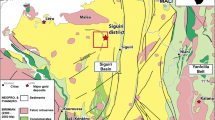Abstract
The Taparko gold deposit, located in the eastern branch of the Proterozoic Birimian Bouroum-Yalogo greenstone belt (Burkina Faso) consists of a network of quartz veins developed in a N 170° trending shear zone (250 m wide, 4 km long) superimposed on the regional Birimian structural pattern. The quartz vein network is composed of: (a) a dominant array of quartz veins (type 1), parallel to the shear zone and comprising strongly deformed dark quartz exhibiting foliation, layering, ribbon, tension gashes, etc.; (b) oblique and subparallel related veins (type 2) of gray to white weakly deformed quartz crosscutting the dominant quartz veins resulting in breccia structures; and (c) shallow dipping veins (type 3), cross-cutting veins types 1 and 2 and filled by undeformed white buck structure quartz. Cross-cutting relationships and different quartz types in different veins and within individual veins imply a concomitant filling of the veins during the progressive deformation. Initial sinistral transcurrent shearing evolved with time to sinistral reverse shearing. Metallic minerals occur only in type 1 and 2 veins and were deposited in two stages, with native gold being related to second stage sulfides. Gold (and chalcopyrite) precipitated preferentially upon the surfaces of fractured pyrite grains in low-pressure sites (pressure shadow zones) around and/or within the sulfide grains (along subsequently annealed fractures). The formation of the South Taparko deposit can be divided into a succession of events: (a) during the first event, N 170°-directed sinistral transcurrent shearing resulted in a N 20° mylonitic foliation and fractured rock which allowed H2O-, CO2- and SiO2-rich fluids to circulate and deposit quartz with buck texture; (b) during the second event, type 1 quartz was strongly deformed and type 2 veins formed with sigmoidal shapes as viewed on a horizontal plane; and (c) during the third event, the sinistral transcurrent shearing evolved to sinistral reverse shearing and the deformation style evolved correspondingly from ductile to brittle-ductile. During the last phase of deformation gold nucleated and deposited in low-pressure zones.
Similar content being viewed by others
Author information
Authors and Affiliations
Additional information
Received: 9 July 1997 / Accepted: 23 March 1998
Rights and permissions
About this article
Cite this article
Bourges, F., Debat, P., Tollon, F. et al. The geology of the Taparko gold deposit, Birimian greenstone belt, Burkina Faso, West Africa. Mineral. Deposita 33, 591–605 (1998). https://doi.org/10.1007/s001260050175
Issue Date:
DOI: https://doi.org/10.1007/s001260050175




